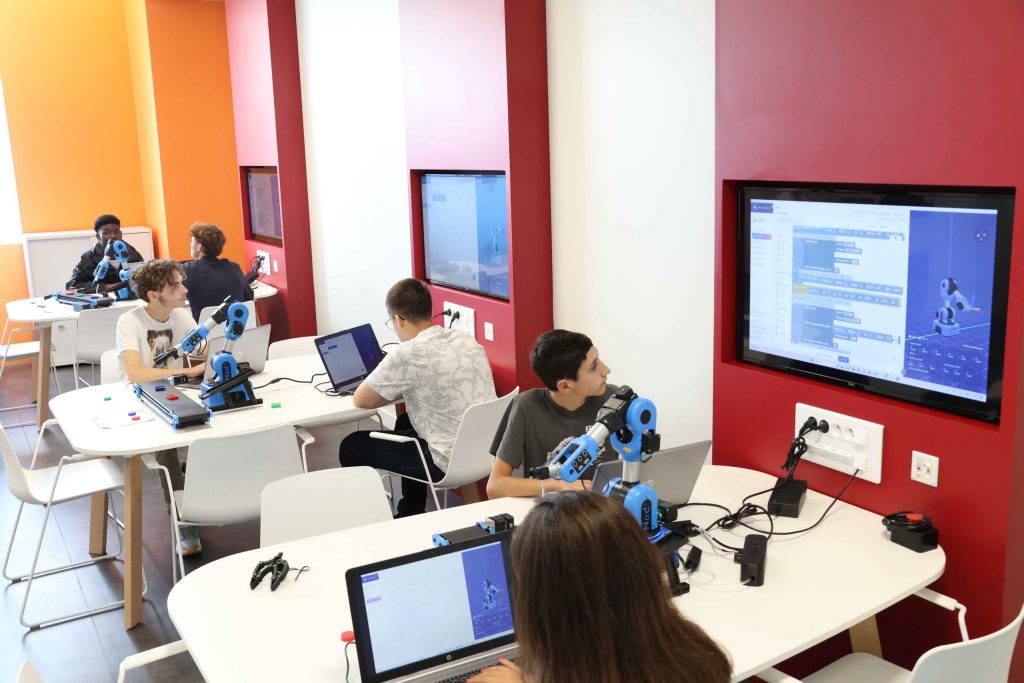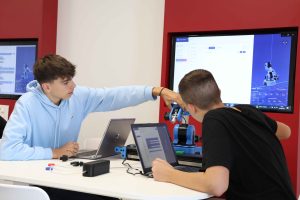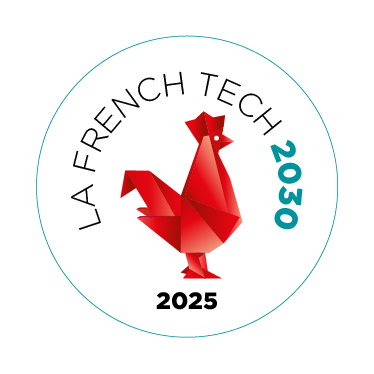The integration of robotics into previously inaccessible sectors is progressing at a rapid pace, and its transformative potential in education is now undeniable.
In a context where engaging young people is a major educational challenge, traditional learning methods often fail to captivate them fully. This raises a fundamental question: how can robotics influence and potentially improve student engagement in the learning process?
Introducing robots in schools offers innovative educational tools. Students are invited to immerse themselves in hands-on projects, manipulate cutting-edge technologies and develop essential skills for the digital age. Activities such as programming a robot, participating in a league, or forming a team for a competition like Robocup stimulate curiosity and collaborative work. They help preparing future citizens for tomorrow’s challenges.
Using robotics to stimulate motivation and interest
With its innovative and interactive nature, robotics is a powerful lever for sparking motivation and interest, particularly among young people. By involving itself in schools, robotics transforms learning into a concrete and exciting experience.
The intrinsic appeal of robots
Robotics naturally captures the attention of young people through its novelty and playful nature. These machines embody the future and cutting-edge technology, sparking immediate curiosity and engagement. The interactive nature of robots makes learning captivating and appealing.
Learning through play and experimentation
In education, robotics offers a concrete medium to understand abstract concepts in physics, mathematics, and programming. “Doing” takes precedence over “undergoing”, encouraging the development of critical thinking and problem-solving. Every robot-related project becomes a dynamic and participatory learning activity, transforming the classroom into a laboratory of ideas.
Development of cross-disciplinary skills
Robotics promotes creativity, innovation, logical and algorithmic thinking through programming. Perseverance and failure management are also reinforced. These educational activities prepare young people for the challenges of the digital world by providing them with essential skills for their future lives. Participating in a RoboCup league or team is an excellent example of this collaborative learning.
Robotics for cognitive and social engagement
Integrating robotics into education is profoundly transforming how young people learn. Robotics is no longer just a cutting-edge technology; it is also a powerful educational tool that puts students at the heart of their learning.
Increased cognitive engagement
Educational robotics promotes active and in-depth learning. Through concrete projects, students become active participants in their own learning. Programming a robot provides immediate feedback, allowing students to adjust and deepen their understanding. Theoretical knowledge is thus contextualized, making teaching more relevant.
Social engagement and collaboration
Robotics projects encourage teamwork and cooperation. Participating in group activities, such as a league or the RoboCup, helps young people develop essential interpersonal skills such as negotiation and conflict resolution. Knowledge sharing becomes second nature, reinforcing mutual support and team spirit.
Inclusion and differentiated instruction
Robotics offers multisensory approaches that can be adapted to various learning styles. These approaches are particularly motivating for struggling students, offering them a new path to success. Challenges can be adapted to different levels, ensuring effective inclusion and differentiated instruction. Thus, schools are equipped with innovative digital resources that prepare students for the challenges of modern life.
Challenges and limitations of robotics integration
The integration of robotics is inherently linked to significant challenges and limitations that must be rigorously addressed.
Cost and accessibility
The initial investment in programmable robots’ equipment and maintenance is a significant financial obstacle for many schools. Beyond the acquisition of the machines, the need to devote substantial resources to teacher training generates additional costs. This exacerbates the digital divide, creating a gap between well-equipped institutions and those struggling to keep up with this cutting-edge technology.
Teacher training and support
Successful integration of robotics requires teachers to acquire specific technical and pedagogical skills. Resistance to change and apprehension about these new technologies are natural reactions that should be managed through ongoing support and appropriate training. The goal is to enable teachers to fully integrate robotics into their teaching activities and projects, rather than just introducing programming basics.
Assessing real and lasting impact
Measuring students’ long-term engagement with robotics is a crucial issue. There is a risk that the novelty effect will wear off, reducing robots to the status of gadgets. It is essential that robotics be seen as a tool for acquiring skills rather than an end in itself. The success of a robotics project should be measured not only by participation in a league or the smooth running of a RoboCup team, but also by the ability to generate lasting interest in science and technology.
Ethical and educational considerations
Integrating robotics raises ethical questions, particularly regarding technological dependence. It is essential to strike a balance between digital learning and developing soft skills, such as teamwork and critical thinking. Robots should enrich the learning experience without overshadowing human interaction. Educational platforms should aim to train citizens to master these tools, not to be dependent on them.
















